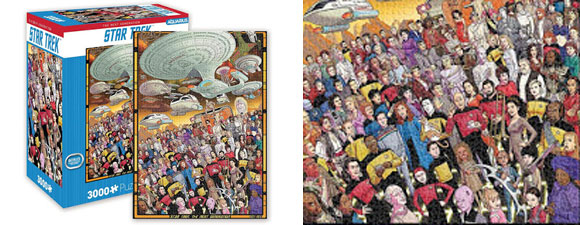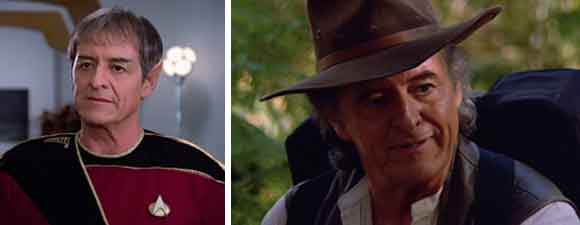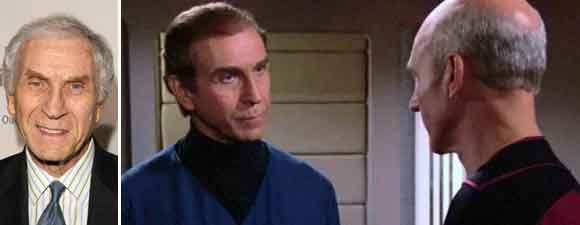Retro Review: Force of Nature
6 min readA brother-sister team attempts to demonstrate that the use of warp engines is destroying the fabric of space.
Plot Summary: The Enterprise is sent to investigate the disappearance of the medical transport Fleming in the Hekaras Corridor, mapped by the Federation to allow ships to pass through a region with a powerful tetryon field. The crew suspects a nearby Ferengi ship may have stolen the valuable cargo, but when the Enterprise finds the Ferengi, their ship has been disabled, for which Daimon Prak blames a weapon designed as a Federation signal buoy. The Ferengi direct the Enterprise toward the Fleming in exchange for help repairing their engines, but once the Fleming is detected, the Enterprise too is disabled by a verteron pulse from what appears to be a signal buoy. A ship approaches carrying a pair of Hekaran scientists, the brother and sister team of Rabal and Serova, who claim that they have discovered that warp fields are destroying their planet and its region of space, but the Federation will not listen. LaForge believes that their conclusion – that all warp travel in the region must cease – is premature, but Data believes that the damage may be significant and suggests further research. Fearing more delays, Serova creates a warp breach in the Hekaran ship, destroying it and herself to prove that large warp fields tear local space. An enormous rift results, which swallows up the Fleming. Data suggests coasting into the rift to save the Fleming’s crew, but the Enterprise is unable to contact the other ship and when the Fleming tries to activate its warp drive to escape, the rift grows and traps the Enterprise. Once the Fleming crew has been beamed aboard, LaForge tries to use the Enterprise’s deflector shields to coast back out of the rift on a distortion wave, but the ship is nearly destroyed by the turbulence. When they finally reach normal space, Rabal shows the crew a projection of how space will be damaged if ships continue to use warp drive. The Federation Council immediately orders all Federation vessels to maintain a speed of warp five except during emergencies, which Worf says the Klingons will accept as well, though he suspects the Romulans and others will not. Picard expresses regret that their exploration of the universe may have damaged it, while LaForge is confident that they can find a solution to reverse the damage.
Analysis: Obviously, “Force of Nature” was well-intentioned, meant as a message about the dangers of unchecked environmental hazards in our own era. But it’s plodding, didactic, and ultimately infuriating. Ten minutes into the episode, there’s still no hint what it will be about. Most of the “action” – by which I mean walking around corridors and the engine room – concerns LaForge’s attempts to get Data to train Spot to stay off the furniture and Data’s attempts to understand why LaForge is competitive about engine efficiency with the chief engineer of the Intrepid. It’s always nice to see their friendship develop, but these discussions are extremely tangential to the storyline about the hazards of warp drive unless one really stretches to make a connection between untrainable cats and unmanageable warp fields. Plus they’re packed with technobabble about the ship’s sensors, something it’s hard to make the audience care about even when there’s a crisis in which they’re necessary; when it’s just routine maintenance, it’s like watching futuristic plumbers at work on unrecognizable equipment.
Things pick up a bit when the Ferengi arrive, but disappointingly, they’re not villains here, just suspicious and incompetent at fixing their own engines. They’re red herrings in the disappearance of the Fleming, as is a debris field that at first Picard believes is the wreck of the ship. As it happens, the Fleming’s crew is fine, though we never get to see them and really don’t care about them by the time we find this out. I’m not sure how much we’re supposed to care about Rabal and Serova, either; as Data points out, the latter is so shrill and single-minded that she fails to convey the message that’s of such urgency that she’s willing to die for it, whereas Rabal just seems sort of colorless, concerned about his people and sorry to see his sister die, but lacking in real passion about either. He’s mostly around as a plot device to explain the hazards of warp fields and the ultimate fate of the universe if Starfleet keeps using them in the Hekaran Corridor. He might be willing to cut his people off from the rest of the universe to protect them from warp fields, but I wonder whether, say, if scientists in California learned that airplanes were exacerbating turbulence along the San Andreas Fault, anyone let alone everyone in Los Angeles would agree never to fly anywhere again in order to postpone the still-inevitable Big One that probably won’t happen during their lifetimes. It seems apparent that these two rogue scientists aren’t being listened to by their own government, let alone by Starfleet, and while there are fair parallels with the way scientific research about global warming has been dismissed by Earth governments, it also tends to make Serova look more like the lone loony whom LaForge first takes her to be than someone whose work demands attention.
These are all very minor nitpicks, though, compared to the whopper of silliness at the end of the episode. The fictional device of warp travel has been the basis for Star Trek’s exploration of the universe since Kirk first took his Enterprise where no man had gone before. To announce that the sci-fi gimmick that’s been the catalyst for the entire franchise is in fact one of the great evils in the universe is akin to producing an episode of a NASCAR show in which a team of outside scientists arrive, announce that cars contribute to atmospheric pollution, and get the drivers to agree that from now on they’ll race only on bicycles. In principle, it may strike a blow for environmental awareness, but how many members of the audience are ever going to tune in again, let alone take the message to heart? Nobody likes a lecture, and nobody likes abrupt extremist solutions dropped into place via dictates from on high. I’m all for stronger environmental legislation, but can you imagine if Congress passed a law stating that starting immediately, Americans could only drive at 30 miles per hour unless they drove ambulances, and no one could fly overseas except on official business? That’s pretty much what the Federation does at the end of this episode. Of course the Romulans aren’t going to go along with it, and while Worf thinks the Klingon Council won’t want to anger Starfleet, who thinks the Duras sisters will care what the Council dictates?
As I recall, a few mentions of the warp limitations get made in upcoming episodes, and by the time of Voyager – whose titular starship must travel at top speed to have any chance of making it home within two generations, and whose crew actually will experiment with risky Warp 10 travel – it will have been dropped altogether, without any satisfactory scientific explanation of new engines or new methods of warp propulsion that don’t cause the same damage to the fabric of space. It would have been nice had some character actually explained how the warp-capable races of the universe solved the problem, and whether they changed first contact procedures so that species on the verge of warp travel could be warned about the hazards of doing it the way humans, Klingons, and everyone first tried…or else if we were told that the Hekarans were wrong after all, even though that would mean Serova sacrificed herself for nothing and would serve as a warning about save-the-world fanaticism rather than a symbol of passionate devotion to environmentalism. For once, I’m all in favor of a plot point being dropped utterly, because there’s no good way to address the clunker from “Force of Nature.” Like later Star Trek writers, I’d rather forget all about it, except the cute scenes with Data discovering that he’s more trainable than his kitty.






